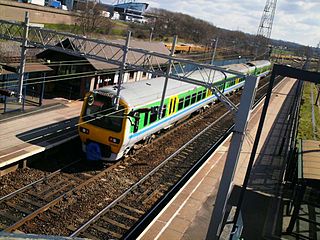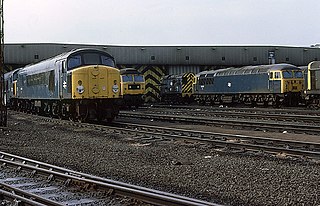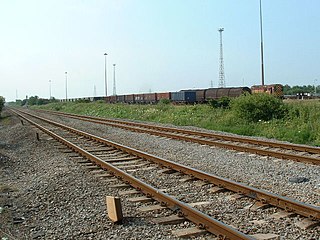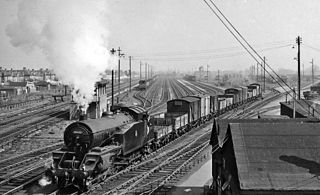
Severn Tunnel Junction railway station is a minor station on the western side of the Severn Tunnel in the village of Rogiet, Monmouthshire, Wales. It is 123.5 miles (198.8 km) from London Paddington and lies at the junction of the South Wales Main Line from London and the Gloucester to Newport Line.

The Chase Line is a suburban railway line in the West Midlands region of England. It runs from its southern terminus, Birmingham New Street, to Walsall, and then Rugeley Trent Valley in Staffordshire, where it joins the Trent Valley line. The name of the line refers to Cannock Chase which it runs through at its northern end.

A rail yard, railway yard, railroad yard (US) or simply yard, is a series of tracks in a rail network for storing, sorting, or loading and unloading rail vehicles and locomotives. Yards have many tracks in parallel for keeping rolling stock or unused locomotives stored off the main line, so that they do not obstruct the flow of traffic. Cars or wagons are moved around by specially designed yard switcher locomotives (US) or shunter locomotives (UK), a type of locomotive. Cars or wagons in a yard may be sorted by numerous categories, including railway company, loaded or unloaded, destination, car type, or whether they need repairs. Yards are normally built where there is a need to store rail vehicles while they are not being loaded or unloaded, or are waiting to be assembled into trains. Large yards may have a tower to control operations.

Aston railway station serves the districts of Aston and Nechells in Birmingham, England. The passenger entrance is on Lichfield Road and accessible via the staircase or lifts to take you to the platform which is raised. The station is on the Cross-City Line and the Chase Line. It is one of two local stations for Aston Villa Football Club and near to the Aston Expressway and to Gravelly Hill Interchange.

Walsall railway station is the principal railway station of Walsall, West Midlands, England and situated in the heart of the town. It is operated by West Midlands Trains, with services provided by West Midlands Railway. The main entrance is situated inside the Saddlers Shopping Centre.

Tinsley was a railway marshalling yard near Tinsley in Sheffield, England, used to separate railway wagons from incoming trains and add them to new trains. It was sited immediately west of the M1 motorway, about one mile north of the Catcliffe junction. It was opened in 1965, as a part of a major plan to rationalise all aspects of the rail services in the Sheffield area; it closed in stages from 1985, with the run-down of rail freight in Britain. It was also the site of Tinsley Traction Maintenance Depot (TMD), which was closed in 1998; at its peak, 200 locomotives were allocated to this depot.
The South Staffordshire line is a partially mothballed and active former mainline that connects Burton-upon-Trent to Lichfield in Staffordshire and formerly then to the West Midlands towns of Walsall, Wednesbury, Dudley and Stourbridge. However, Dudley and Stourbridge were already joined to the Oxford, Worcester and Wolverhampton Railway's (OW&WR) line just north of Dudley Station. It in essence, continued to Stourbridge along with Wednesbury and Walsall.

Bescot Stadium railway station serves the Bescot area of Walsall in the West Midlands of England. The station is located in the borough of Sandwell, although it can only be reached from within the borough of Walsall. The station, and most trains serving it, are operated by West Midlands Railway.

Bescot TMD is a locomotive traction maintenance depot in Bescot, an area of Walsall in the West Midlands, England. Situated adjacent to Bescot Stadium railway station, the depot with code BS is currently operated by DB Schenker Rail (UK). Bescot Yard is to the south-east of the depot. This entire complex of track is clearly visible from the northern end of the M6 and M5 motorway junction. The Depot is on the Chase Line and the Walsall-Wolverhampton Line.

Toton Traction Maintenance Depot or Toton Sidings is a large traction maintenance depot located in Toton, Nottinghamshire. The TOPS depot code for the depot is TO. Before TOPS, the shed code was 16A.

Brettell Lane railway station was a station on the Oxford-Worcester-Wolverhampton Line which served the town of Brierley Hill in England.

Wath marshalling yard, also known as Wath concentration yard, was a large railway marshalling yard specifically designed for the concentration of coal traffic. It was set at the heart of the South Yorkshire Coalfield, at Wath-upon-Dearne, approximately halfway between Barnsley and Doncaster, in the United Kingdom. It opened in 1907 and closed in 1988.

Margam Knuckle Yard is a railway yard in Margam, South Wales, on the South Wales Main Line, operated by DB Schenker Rail (UK). The yard is the major freight yard of the region, handling all of the rail freight movements from Port Talbot Steelworks, and most of the railfreight traffic around South Wales.

Feltham marshalling yard, also known as Feltham hump yard, was a large railway marshalling yard designed for the concentration of freight traffic to and from South West London, and for transfer to other marshalling yards in London. It was built on the Waterloo–Reading line. It opened in 1918 and was closed by British Railways on 6 January 1969.

Tees Marshalling Yard is a railway marshalling yard, used to separate railway wagons, located near Middlesbrough in North Yorkshire, Northern England.

Healey Mills Marshalling Yard was a railway marshalling yard located in the village of Healey, south west of Ossett in West Yorkshire, England. The yard was opened in 1963 and replaced several smaller yards in the area. It was part of the British Transport Commission's Modernisation plan, and so was equipped with a hump to enable the efficient shunting and re-ordering of goods wagons. The yard lost its main reason for existence through the 1970s and 1980s when more trains on the British Rail system became block trains where their wagons required less, or more commonly, no shunting.

Basford Hall Yard is a railway marshalling yard near the town of Crewe, Cheshire, England. The yard, which is 0.93 miles (1.5 km) south of Crewe railway station, was opened in 1901 by the London and North Western Railway (LNWR). Initially used to marshal trains, the site now acts as a hub mainly for Freightliner intermodal trains, but also houses departmental sidings as used by Freightliner Heavy Haul, and other operators. For a period in the 1930s, Basford Hall was the busiest marshalling yard in Europe, handling between 28,000 and 47,000 wagons every week.

Dringhouses Yard was a railway freight marshalling yard on the East Coast Main Line (ECML), south of York railway station in England. The yard was built during the First World War to help with the increase in traffic caused by the support to the British war effort. The yard was modernised in the 1960s, being fitted with a hump (knuckle), to ease shunting operations. It was closed to all traffic in 1987 after the loss of local railfreight traffic around York.

Washwood Heath Yard was a marshalling yard, and later sidings, to the east of Birmingham, in the West Midlands, England. The site was first host to sidings in the late 1870s, which were upgraded to a hump marshalling yard by 1900 which survived until the early 1980s. Thereafter, the site was flat shunted, but moreover used as a layover yard, rather than used for the transfer or interchange of wagons between trains. It was run-down and closed in late 2008 due to the loss of most of the automotive traffic that it was latterly used for. The lines were removed by 2020.
Perth New Yard is a former railway marshalling yard in the city of Perth, Scotland. The yard was built in the early 1960s to gather traffic from around the Perth area and goods wagons from the lines radiating from Perth. It was latterly used as an engineering and wagon storage depot until it was finally closed in 2008. Though abandoned, the site is registered with Canmore, the Historic Environment Scotland.





















